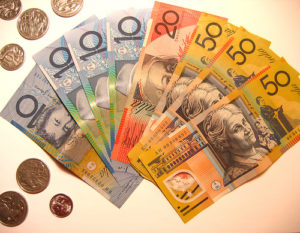 Australian dollar gained ground against its US rival on trading Thursday, after data showed Australias retail sales rose at a pace three times faster than projected, while the surplus on nations trade balance widened the most in 2.5 years.
Australian dollar gained ground against its US rival on trading Thursday, after data showed Australias retail sales rose at a pace three times faster than projected, while the surplus on nations trade balance widened the most in 2.5 years.
AUD/USD climbed to a session high at 0.9034 at 0:32 GMT, which has been the pairs highest level since February 25th. At 7:09 GMT AUD/USD was trading at 0.9018, gaining 0.38% for the day. Support was likely to be received at March 5th low, 0.8941, while resistance was to be encountered at February 25th high, 0.9044.
According to official data released earlier in the day, Australias trade balance produced the widest surplus since August 2011, supported by iron ore and gold export. Exports surpassed imports by 1.433 billion AUD in January, following a revised up surplus figure of 0.591 billion AUD during the preceding month (0.468 billion AUD previously). Preliminary estimates pointed to a considerably lesser trade surplus in January, amounting to 0.100 billion AUD.
At the same time, retail sales in the country rose at a monthly pace of 1.2% in January, or the fastest rate in the past 11 months and also outperforming forecasts of a 0.4% gain. Sales have been supported by higher spending at universal stores and restaurants. In December the value of the retail sales index has been revised up to a gain of 0.7% from a gain of 0.5% previously.
These data points came out one day after the Australian Bureau of Statistics reported that nation’s Gross Domestic Product climbed 0.8% in the final quarter of 2013 compared to the prior quarter, beating experts’ estimates pointing to a 0.7% increase, while in Q3 compared to Q2 economy expanded 0.6%. The annualized GDP rose 2.8% during Q4, again above forecasts of a 2.5% gain. The result implied that Reserve Bank of Australia’s measures to spur economic growth through higher consumer expenditures have begun to pay off.
A separate report by the Australian Industry Group (AIG) showed that the Performance of Services Index (Australian PSI) improved to a reading of 55.2 in February from 49.3 in the preceding month.
Meanwhile, the US dollar lost ground against major peers yesterday, after the Automatic Data Processing Inc. (ADP) said private sector in the United States added fewer than expected new jobs during February, which raised concerns over the development of nations labor market. Companies operating in the private sector hired 139 000 workers last month, which mismatched the median estimate of analysts, pointing to a gain of 158 000. Januarys figure has been revised down to 127 000 jobs added from 175 000 jobs, as announced previously. The ADP report is considered as a precursor to the official employment data, scheduled to be published on Friday.
Non-farm payrolls probably rose by 146 000 in February, according to the median forecast of experts, after in January economy added 113 000 jobs. The rate of unemployment in the United States is expected to remain steady at 6.6%, or the lowest level since October 2008.
In addition, activity in the US sector of services increased in February, but at a slower than projected pace, with severe weather conditions causing a partial influence on the indicator. According to the Institute for Supply Management (ISM), the corresponding non-manufacturing PMI dropped to a reading of 51.6 in February, which has been the lowest since February 2010, while in January the index came in at 54.0. Experts had anticipated a lesser slowdown in the value of the index last month, to 53.5. Values above the key level of 50.0 are indicative of expansion in the sector.
The sub-index, gauging employment, plunged to a reading of 47.5 in February, or the weakest level since March 2010, as severe winter adversely influenced hiring in sectors such as wholesale trade and construction. The sub-index of new orders rose to 51.3 in February from 50.9 a month ago, while the gauge of output fell 1.7 points to reach 54.6 last month.
Elsewhere, the Aussie was gaining against the euro, with EUR/AUD cross down 0.43% on a daily basis to trade at 1.5222 at 8:03 GMT. AUD/NZD rose 0.12% to trade at 1.0689 at 8:04 GMT. The pair earlier touched a daily high at 1.0732, which has been the highest point since February 27th.





